

Global high-mix volume high-speed PCBA manufacturer
9:00 -18:00, Mon. - Fri. (GMT+8)
9:00 -12:00, Sat. (GMT+8)
(Except Chinese public holidays)


Global high-mix volume high-speed PCBA manufacturer
9:00 -18:00, Mon. - Fri. (GMT+8)
9:00 -12:00, Sat. (GMT+8)
(Except Chinese public holidays)
HomePage > Blog > Knowledge Base > A Comprehensive Guide to SMD Diode, LED, Capacitor, Inductor and IC Polarity Identification
Surface mount components are the core of modern high-density, compact electronic PCB assemblies. These miniature components not only save space but also support automated production and high-speed signal transmission. However, it must be noted that many SMD components are polarized. They must be installed in the correct direction in the circuit. If the polarity is identified incorrectly and installed, it will cause the circuit to fail to work, or even result in short circuits or damage.
Therefore, correctly identifying and understanding the polarity of SMD components, especially the most common SMD diode polarity, LED polarity, capacitor polarity, etc., is very important. We can determine the positive and negative terminals—or the cathode and anode—of a component through the markings on the component body and the polarity symbols printed on the circuit board.
In this article, we will discuss how to identify the polarity of SMD components. After reading this article, you will surely be able to master the polarity identification of diode, LED, capacitor, inductor and IC.
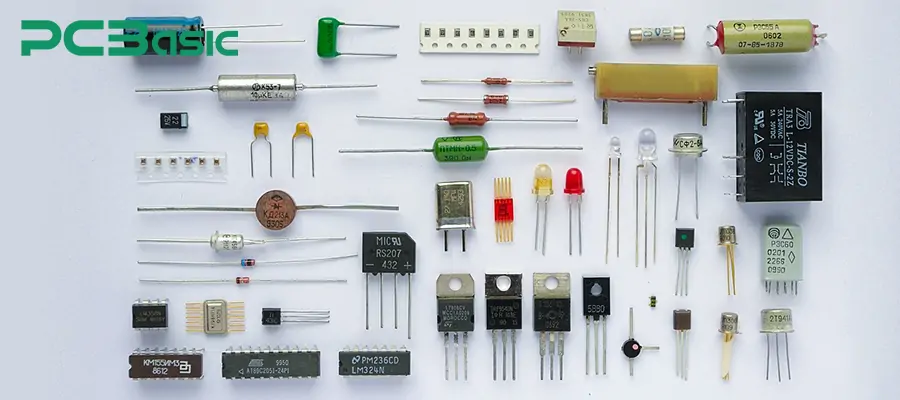
The SMD polarity refers to the electrical directionality that the surface mount components need to follow when being soldered onto the circuit board. That is to say, for some components, there are two pins with distinct electrical properties: one is the positive pole (anode), and the other is the negative pole (cathode). Only when they are installed in the correct direction can the circuit function properly. If the polarity is reversed, it will cause the circuit to fail, or even result in the component burning out or the circuit being damaged.
Therefore, correctly identifying the polarity marks on the components and understanding the silk-screen symbols on the circuit board is very fundamental and essential. We need to ensure that the component orientation matches the circuit board, ensuring the reliability and safety of the circuit. Note that not all SMD components have polarity. For example, resistors and ceramic capacitors are non-polar components, and they can work properly regardless of the orientation. So which SMD components have polarity? We will explain this to you in the next part.
Modern PCB assembly often uses a large number of surface mount components, many of which are polarized. Below, we list the most common types of polarized surface mount components:
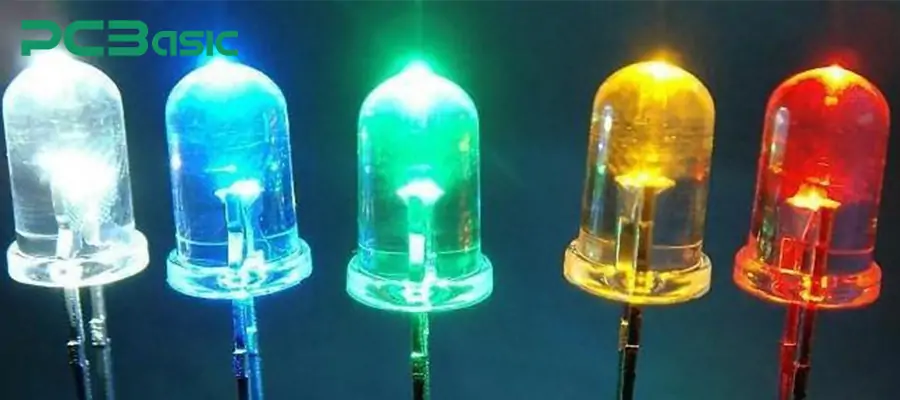
All types of diodes are essentially one-way conducting devices and inherently possess polarity. Whether it is a general-purpose diode used for rectification or a voltage-clamping diode used for voltage clamping, they can only allow current to flow from the anode to the cathode. Therefore, the installation of diodes must be correct. If the installation direction is reversed, the diode will prevent the current from passing through, resulting in circuit interruption.
Among them, LED (Light Emitting Diode) is a special type of diode and is also one of the most common polarity devices. Only when the current flows from the anode to the cathode can the LED emit light. The polarity of the LED cannot be ignored because it has very wide applications, and any incorrect installation direction will cause batch failures or rework.
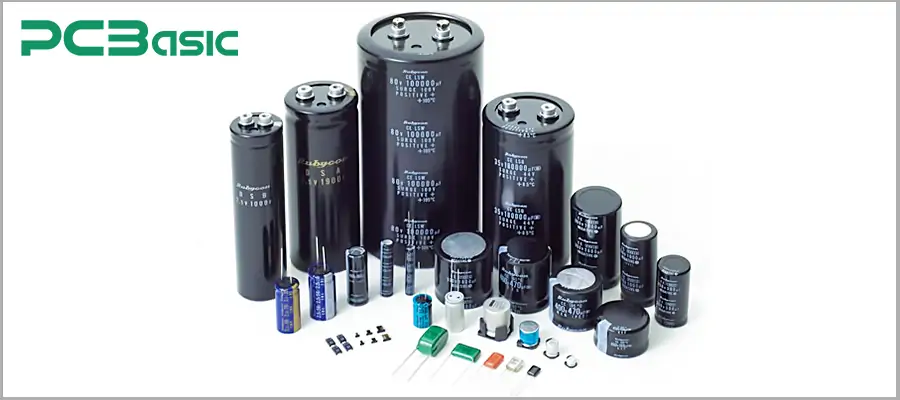
Among all types of capacitors, tantalum capacitors and aluminum electrolytic capacitors are the most typical strong-polarity components. They are widely used in power filtering, energy storage, voltage stabilization and other fields.
Tantalum capacitors have the advantages of small size, high capacitance and good temperature stability. However, they are extremely sensitive to reverse voltage. Once the polarity is reversed, even at low voltages, an internal short circuit may occur, causing the capacitor to burst or catch fire.
Aluminum electrolytic capacitors, on the other hand, are widely used in various power supplies and voltage conversion modules due to their high capacity and low cost. Their operation relies on the oxide film formed between the aluminum foil and the electrolyte. This film can only be effectively formed in one direction. The electrolytic capacitor polarity cannot be reversed either. Once reversed, the film will be damaged, leading to the failure of the capacitor.
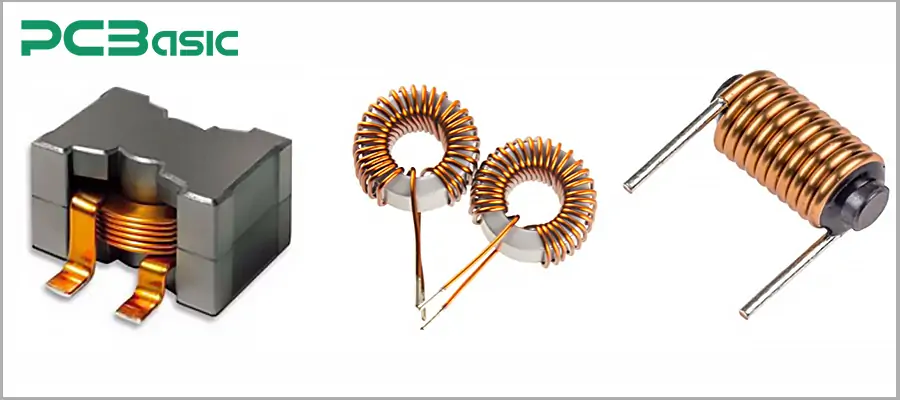
Inductors are mostly non-polar, as their functions are essentially independent of the direction of current flow. They can be installed in any orientation without affecting the electrical performance.
However, in certain specific application scenarios, such as in switching power supplies or inductive coupling, the inductor itself may have a marked starting point of the winding. This starting point is usually represented by a small dot or a short line. Such markings are not due to polarity requirements but are for maintaining consistency in circuit design or system assembly.
Although reversing the direction of these inductors usually does not cause damage to the device, in complex systems, a unified orientation may have subtle effects on EMC performance or magnetic coupling behavior. Therefore, when encountering inductors with orientation markings, we recommend following the schematic or design specifications for installation.
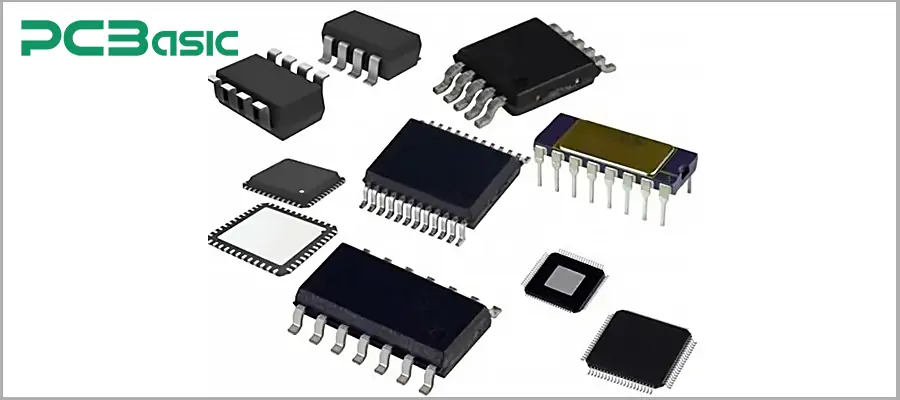
Integrated circuits do not belong to the traditional category of "polar components". However, their installation on the PCB has specific direction requirements. During the design of the package, the position of pin 1 of the IC is clearly distinguished. (Pin 1 serves as the starting point for the numbering and logical function distribution of all the internal pins of the chip.) If the direction is incorrect during installation, it will cause disordered connections between the chip and the external circuit; in the worst case, the chip may malfunction temporarily or even be instantly burned out.
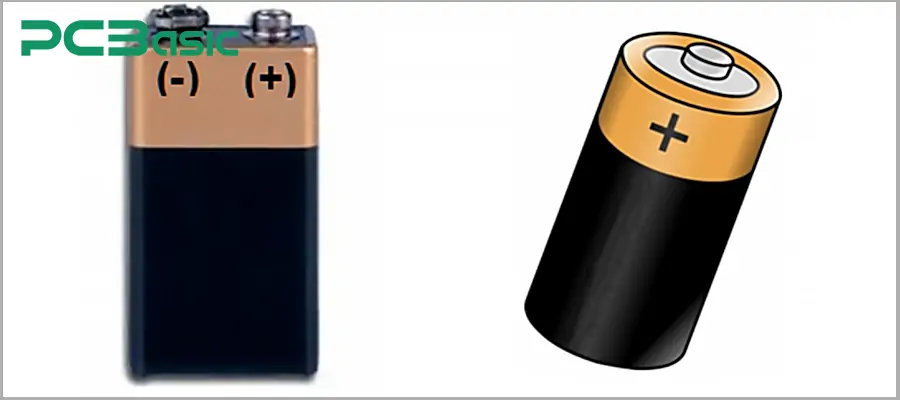
Batteries (such as lithium batteries) and integrated power management modules usually have the strictest polarity definitions. These devices have a large supply current and high energy density. If the polarity is reversed, there is a high possibility that the circuit board will be instantly damaged, leading to serious consequences such as overcurrent, short circuit or thermal runaway.
Therefore, in summary, correctly installing components is the first step to avoiding electronic product malfunctions.
Next, we will provide a detailed explanation on how to identify and determine the polarity of surface mount components.
The cathode (-) of a diode is usually represented by stripes, lines or dots and is usually printed on one end of the housing; the anode (+) is the unmarked side.
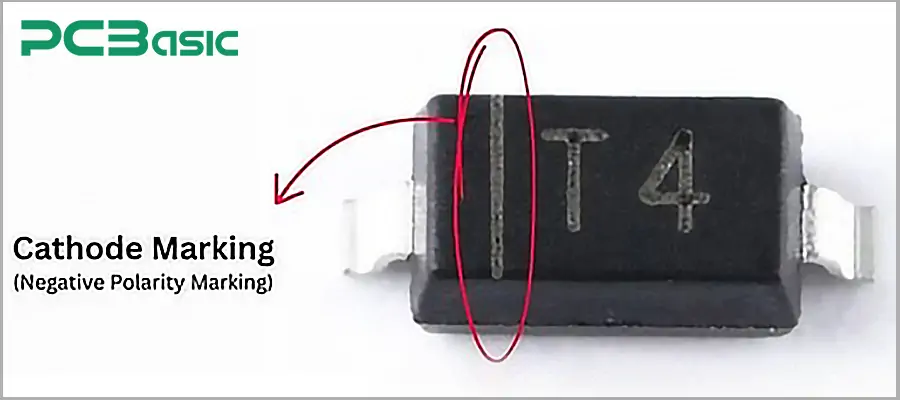
Common on PCB silk-screening:
A short line aligned with the component stripe;
Or directly print the complete diode circuit symbol, with the arrow pointing to the cathode.
Common Package Types and Polarization Markings of Diodes
|
Package Type |
Cathode Marking |
Typical Applications |
|
SOD-123 |
Stripe on one end |
Signal, Schottky, Zener |
|
SMA / SMB |
Stripe or band |
Rectification, TVS protection |
|
SOT-23 |
Dot or notch |
Dual diodes, small-signal circuits |
|
MELF |
Band on one end |
High-reliability applications |
The common markings for the LED cathode include chamfered edges of the housing, small dots, a short line on one side, and short pins (but SMD types usually have no pins), while the anode (+) is at the other end.
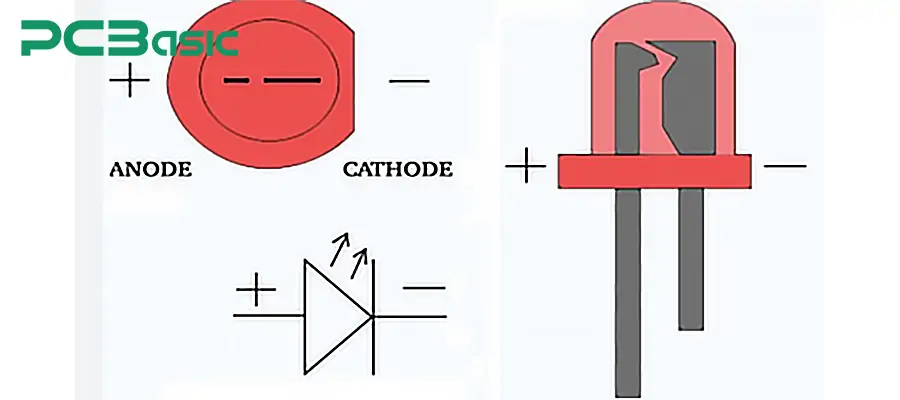
The silk-screening on the PCB usually features a T-shaped pad as the anode; the side of the line pointed by the arrow; or the position of small dots or notches.
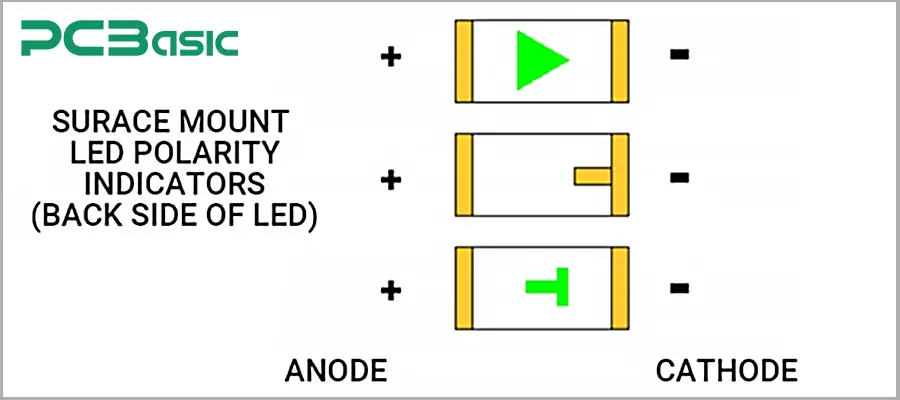
In the previous chapter, we mentioned that the most representative types of capacitors are tantalum capacitors and aluminum electrolytic capacitors. Therefore, we will take these two as specific examples for analysis in the following section.
Tantalum capacitor
On the tantalum capacitor component, the anode (positive pole) is indicated by stripes or a "+" symbol(as shown in the figure). While the PCB silk screen usually marks the "+" sign next to the anode pad, or uses a special-shaped pad to represent positive and negative. The side with the stripes should correspond to the "+" symbol.
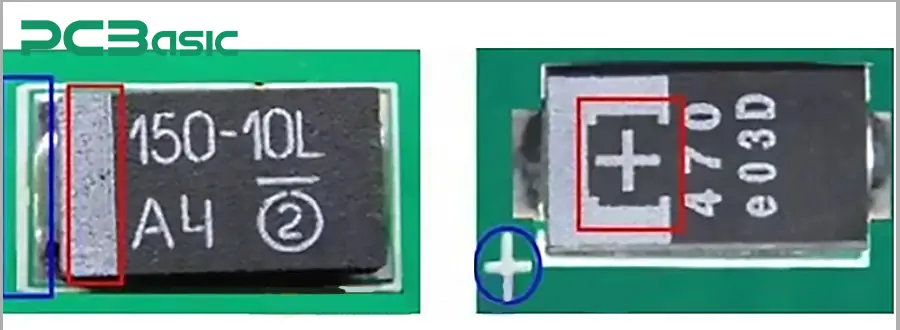
Note: Even if the tantalum capacitor is connected incorrectly and does not get damaged initially, it may still rupture during long-term operation or upon power-on.
Aluminum electrolytic capacitor
On the negative (anode) side of the aluminum electrolytic capacitor, a stripe or the symbol “—” is used to indicate it (as shown in the figure). On the PCB, a shaded area is usually drawn on the negative terminal pad, or the symbol “—” is marked.
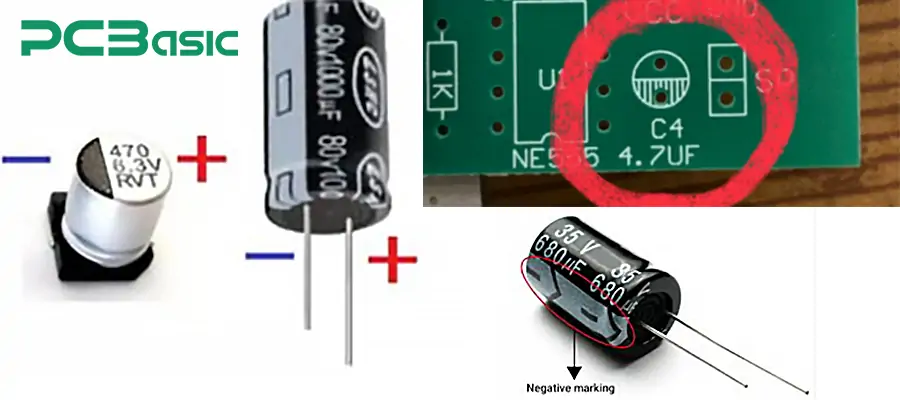
In the previous paragraph, we already mentioned that most surface-mount inductors are non-polar. However, in certain application scenarios, there may be a dot, a short line, or a chamfered edge marked on the component body to indicate the starting end of the winding. As shown in the figure below,
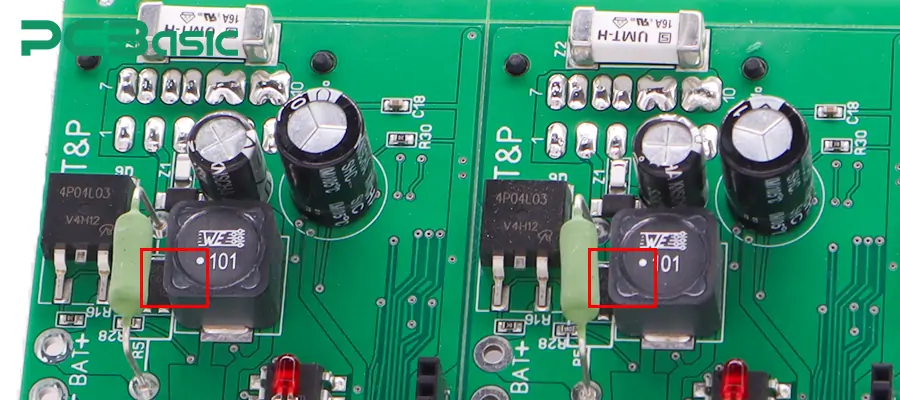
When installing the IC, it is essential to ensure that pin 1 is correctly aligned in the right direction. Usually, on the chip package, pin 1 is marked by small dots, notches, or chamfers (slanted angles).
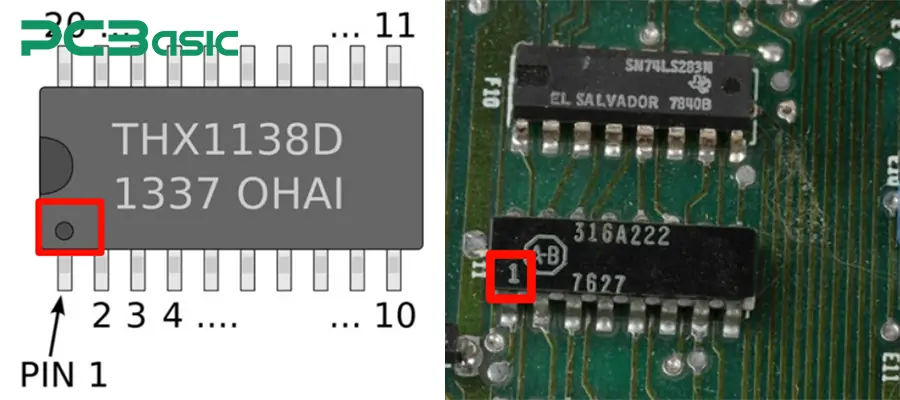
The PCB silk-screening will also be marked accordingly:
The dot at the position of pin 1
The rectangular frame with a notch
The number "1" or the small triangle symbol
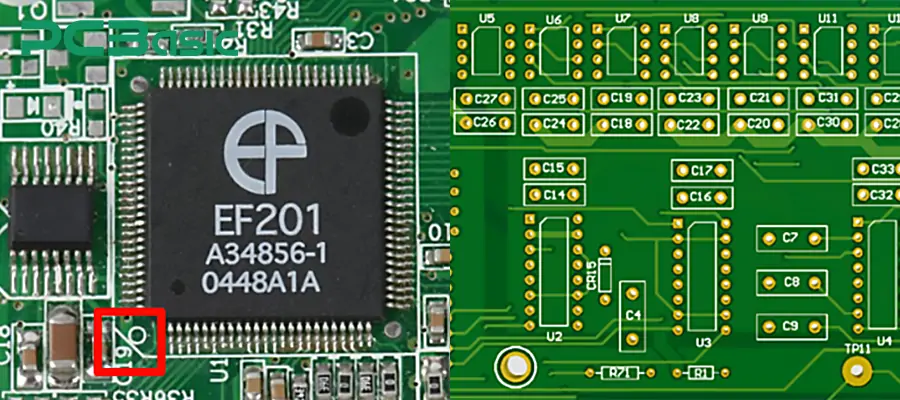
Common Packaging and Pin 1 Marking Method
|
Package Type |
Pin 1 Marking Method |
|
SOIC / SOP |
Small dot or notch on one end of the package |
|
QFP / QFN |
Dot or chamfered corner on one corner |
|
BGA |
Missing ball or dot in one corner |
|
SOT-23 |
Beveled edge or dot on the body |
When the polarity marking on the surface of the component is difficult to identify, we can use a digital multimeter to determine the polarity of the component. The most common method is to use the diode test function of the multimeter.
First, we need to switch the multimeter to the diode function. Then, connect one end with the red probe and the other end with the black probe, and observe the screen reading. If the multimeter shows a normal voltage drop (usually between 0.6V and 0.7V), it indicates that the red probe is connected to the positive pole and the black probe is connected to the negative pole.
If there is no reading during the initial test, it means the connection is reversed. At this time, we need to swap the two probes and retest. If a voltage value appears during the second measurement, then we can know the polarity.
Although many SMD components do not distinguish direction and are flexible in installation, there are also many components that have strict requirements for the correct direction, such as diodes, LEDs, tantalum capacitors, electrolytic capacitors, certain inductors, and ICs, as explained in this article. Accurately identifying the polarity of surface mount components is not only a standard operation but also the foundation for ensuring functionality, reliability, and safety. In conclusion, mastering the identification of SMD component polarities is something that cannot be ignored. This basic skill is often the key to the stable and reliable operation of circuits. I believe that after reading this article, you will be able to accurately identify the polarity of SMD components.
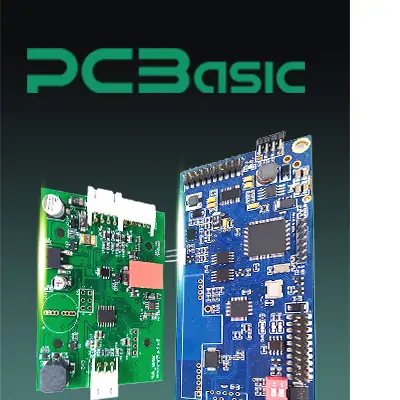 About PCBasic
About PCBasic
Time is money in your projects – and PCBasic gets it. PCBasic is a PCB assembly company that delivers fast, flawless results every time. Our comprehensive PCB assembly services include expert engineering support at every step, ensuring top quality in every board. As a leading PCB assembly manufacturer, we provide a one-stop solution that streamlines your supply chain. Partner with our advanced PCB prototype factory for quick turnarounds and superior results you can trust.

Assembly Enquiry
Instant Quote
Phone contact

+86-755-27218592
In addition, we've prepared a Help Center. We recommend checking it before reaching out, as your question and its answer may already be clearly explained there.
Wechat Support
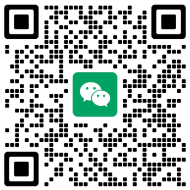
In addition, we've prepared a Help Center. We recommend checking it before reaching out, as your question and its answer may already be clearly explained there.
WhatsApp Support

In addition, we've prepared a Help Center. We recommend checking it before reaching out, as your question and its answer may already be clearly explained there.
